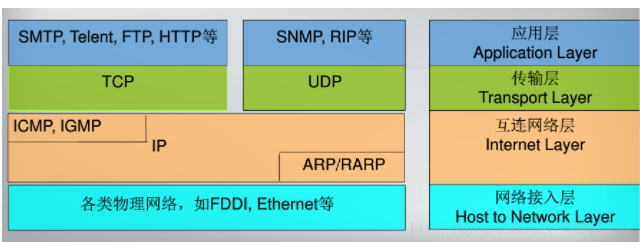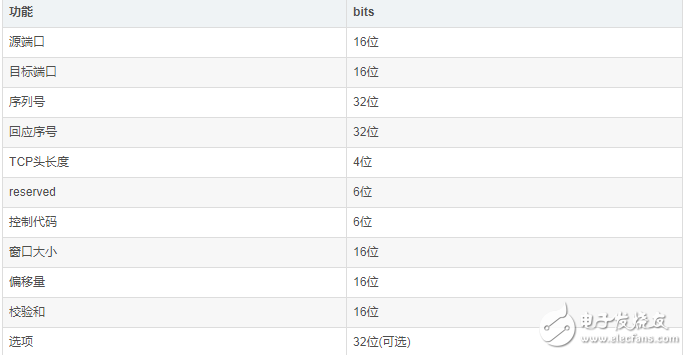The first thing to do is to clarify the relationship between the TCP, UDP, and TCP/IP architectures.

The TCP/IP system has an application layer, a transport layer, an internet layer, and a network interface layer. Four-tier structure, each layer has a different network protocol.
Application layer
HTTP Hypertext Transfer Protocol (Basic Protocol for the World Wide Web)
FTP Simple File Transfer Protocol
Telnet remote login protocol provides remote access to other host functions, allowing users to log in
SNMP Simple Network Management Protocol provides methods for monitoring network devices, configuration management, statistics collection, performance management, and security management
Internet layer
IP Protocol Internet Protocol
ICMP protocol control information protocol
ARP protocol address resolution protocol
RARP Reverse Address Resolution Protocol
Network interface layer
The network access layer is also called host-to-network. The functions of the network access layer include the mapping of IP addresses and physical address hardware, and the encapsulation of IP into frames. Based on different hardware types of network interfaces, the network access layer defines the connection to the physical media.
So TCP/IP system is a protocol cluster, and TCP protocol and UDP protocol are only two different transmission protocols of the transport layer.
2.TCP&UDPTCP (Transmission Control Protocol) is a connection-oriented protocol, that is, before sending and receiving data, it must establish a reliable connection with the other party. A TCP connection must be established after three "dialogues". The process is very complicated and simply describes the simple process of the three dialogs:
Host A sends a connection request packet to host B: "I want to send you data, can I?"
Host B sends a packet to Host A that agrees with the connection and requires synchronization (synchronous is the sending of one of the two hosts, a receiving, coordination): "Yes, when are you sending?"
Host A then sends out a packet confirming that Host B's request is synchronizing: "I'll send it now, and you go ahead!"
The purpose of the three "dialogues" is to synchronize the sending and receiving of data packets. After three "conversations", host A will formally send data to host B.
UDP (User Data Protocol)
UDP is a non-connected protocol. Before the data is transmitted, the source and the terminal do not establish a connection. When it wants to transmit, it simply grabs the data from the application and throws it onto the network as quickly as possible. At the sending end, the speed at which UDP sends data is limited only by the speed at which the application generates data, the capabilities of the computer, and the transmission bandwidth; at the receiving end, UDP puts each message segment in the queue, and the application each time goes from the queue. Read a message segment.
Since the transmission data does not establish a connection, there is no need to maintain the connection status, including the sending and receiving status. Therefore, one server can transmit the same message to multiple clients at the same time.
The header of the UDP packet is very short, only 8 bytes, and the overhead of the 20-byte packet relative to TCP is small.
The throughput is not regulated by the congestion control algorithm and is only limited by the rate of data generated by the application software, the transmission bandwidth, and the performance of the source and the end host.
UDP uses its best efforts to deliver, that is, it does not guarantee reliable delivery, so the host does not need to maintain a complex link state table (there are many parameters here).
UDP is message-oriented. The sender's UDP sends the packet down to the application and delivers it to the IP layer after adding the header. Instead of splitting or merging, the boundaries of these messages are preserved. Therefore, the application needs to select the appropriate message size.
The difference between TCP and UDP:
1. Based on connection and no connection;
2. Requirements for system resources (more TCP and less UDP);
3. UDP program structure is relatively simple;
4. Stream mode and datagram mode;
5. TCP guarantees correctness of data, UDP may drop packets, TCP guarantees data sequence, UDP does not guarantee.
TCP establishes a connection for three handshakes, and disconnects for four connections
Connected three-way handshake
1 Host A sends a data segment containing the flag of the synchronization sequence number to Host B to Host B. It requests Host B to establish a connection. Through this data segment, Host A tells Host B two things:
I want to communicate with you;
Which serial number can you use as the starting data segment to respond to me.
2 After receiving a request from host A, host B responds to host A with a data segment with acknowledgement acknowledgment (ACK) and synchronization sequence number (SYN) flags. It also tells host A two things:
I have received your request. You can transfer data.
Which serial number do you want to use as the starting segment?
3 After receiving this data segment, host A sends a confirmation response to confirm that it has received the data segment of host B: "I have received a reply. I am now going to start transmitting the actual data.
This three-way handshake is complete, Host A and Host B can transmit data.
3 handshaking features
No application layer data
The SYN flag is set to 1 only when the TCP connection is established
The SYN flag is set to 0 after the handshake is completed
Broken four-way handshake
1 After host A completes the data transfer, control bit FIN is set to 1 and a request to stop the TCP connection is made
2 Host B responds to the FIN and confirms that the TCP connection in this direction will be closed, setting ACK to 1
3 The request for closing is reversed in the opposite direction from B, and FIN is set to 1
4 Host A acknowledges the request of host B, sets ACK, and ends the closing in both directions.
The FIN sender completes the sending task bit. When the TCP completes data transmission needs to be disconnected, the disconnected party proposes to set this bit.
ACK: One of the control bits of the TCP header, confirming the data. The confirmation is sent by the destination and used to tell the sender that the data segment before this sequence number was received. For example, the confirmation number is X, indicating that the first X-1 data segments have been received.
When ACK=1, the confirmation number is valid
When ACK = 0, the confirmation number is invalid. At this time, retransmission of data is required to ensure the integrity of the data.
SYN synchronization sequence number, this bit is set when TCP establishes a connection
It can be seen from TCP's three-way handshake and four disconnections that TCP uses a connection-oriented communication method, which greatly improves the reliability of data communications and enables the sending data end and receiving end to interact before data is officially transmitted. Formal transmission laid a solid foundation.
TCP packet header structure:

So we get the minimum length of the TCP packet header, which is 20 bytes.
The UDP header structure:

Outdoor low power LED lamps,Aluminum Alloy LED lamps,LED point light
Kindwin Technology (H.K.) Limited , https://www.szktlled.com